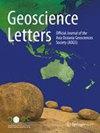Spatiotemporal slip distribution associated with the 2012–2016 Tokai long-term slow slip event inverted from GNSS data
IF 4.3
3区 地球科学
Q1 GEOSCIENCES, MULTIDISCIPLINARY
引用次数: 0
Abstract
We used Global Navigation Satellite System (GNSS) time series data to estimate the spatiotemporal slip distribution for a long-term slow slip event (L-SSE) that occurred in the Tokai region, central Japan, from 2012 to 2016. Since all the used GNSS data were affected by the postseismic deformation associated with the 2011 Mw9.0 Tohoku-Oki earthquake, we removed such postseismic signal from the time series of three components at each of the stations. The minimal time window for an inversion analysis was set to 0.5 years (6 months), taking into account the signal-to-noise ratio of displacements for each time window. In the horizontal displacement fields, displacements were observed in the south‒southeast and southeast directions on the west and east sides of Lake Hamana, respectively, with temporal changes in their amounts and directions. In the vertical displacement fields, uplift was observed on the east side of Lake Hamana. From these data, we estimated the L-SSE initiated in approximately 2012.5 and ended by 2017.0, indicating the duration time is 4.5 years and the duration was much longer than that obtained in a previous study. Using these data, we performed the inversion analysis, in which three a priori information were assumed, i.e., the spatial distribution of slip is smooth, slip mainly occurs in the direction of plate convergence, and the temporal variation in the slip is smooth, to obtain the spatiotemporal slip distribution on a plate boundary with 3-D geometry. As a result, we identified that the L-SSE consisted of two subevents. The first subevent initiated on the southwest side of Lake Hamana and expanded during the period from 2013.0 to 2014.5. The maximum slip velocity during the period from 2012.5 to 2017.0 was estimated to be approximately 3.5 cm/year there for 2013.5–2014.0. The second subevent took place on the west side of Lake Hamana gradually from 2015.0 to 2015.5, continued, and expanded from 2015.5 to 2016.5. From the cumulative slip distribution, we found that its shape spread in the dip direction and obtained a maximum slip of approximately 10.6 cm, a moment release of 2.7 × 1019 Nm, and an equivalent moment magnitude of 6.9. Comparing our results with the L-SSE that occurred in the Tokai region between 2000 and 2005, we found that the slip initiation location was almost the same, but the subsequent slip location was more southerly for the 2012–2016 Tokai L-SSE. Additionally, the maximum slip velocity and moment magnitude were smaller for the 2012–2016 L-SSE.利用全球导航卫星系统数据反演与 2012-2016 年东海长期缓慢滑移事件相关的时空滑移分布情况
我们使用全球导航卫星系统(GNSS)的时间序列数据来估算 2012 年至 2016 年发生在日本中部东海地区的长期缓慢滑移事件(L-SSE)的时空滑移分布。由于所有使用的全球导航卫星系统数据都受到与 2011 年 Mw9.0 东北-冲地震相关的震后变形的影响,因此我们从每个台站三个分量的时间序列中剔除了这种震后信号。考虑到每个时间窗口位移的信噪比,反演分析的最小时间窗口设定为 0.5 年(6 个月)。在水平位移场中,哈马纳湖西侧和东侧分别在东南偏南和东南偏东方向观测到位移,位移量和位移方向随时间变化。在垂直位移场中,哈马纳湖东侧观测到隆起。根据这些数据,我们估计 L-SSE 大约在 2012.5 开始,到 2017.0 结束,表明持续时间为 4.5 年,持续时间远远长于之前的研究。利用这些数据,我们进行了反演分析,假定了三个先验信息,即滑移的空间分布是平滑的、滑移主要发生在板块汇聚方向、滑移的时间变化是平滑的,从而得到了具有三维几何形状的板块边界上的时空滑移分布。因此,我们确定 L-SSE 由两个子事件组成。第一个子事件始于哈马纳湖西南侧,并在 2013.0 至 2014.5 期间扩大。据估计,在 2012.5 至 2017.0 期间,2013.5-2014.0 的最大滑移速度约为 3.5 厘米/年。第二个子事件发生在哈马纳湖西侧,从 2015.0 到 2015.5 逐渐发生、持续,并从 2015.5 到 2016.5 不断扩大。从累积滑移分布图中,我们发现其形状沿倾角方向扩散,并获得了约 10.6 厘米的最大滑移量、2.7 × 1019 牛米的力矩释放量和 6.9 的等效力矩幅值。将我们的结果与 2000 年至 2005 年期间发生在东海地区的 L-SSE 进行比较后发现,2012-2016 年东海 L-SSE 的滑移起始位置几乎相同,但随后的滑移位置更偏南。此外,2012-2016 年 L-SSE 的最大滑移速度和力矩幅度都较小。
本文章由计算机程序翻译,如有差异,请以英文原文为准。
求助全文
约1分钟内获得全文
求助全文
来源期刊

Geoscience Letters
Earth and Planetary Sciences-General Earth and Planetary Sciences
CiteScore
4.90
自引率
2.50%
发文量
42
审稿时长
25 weeks
期刊介绍:
Geoscience Letters is the official journal of the Asia Oceania Geosciences Society, and a fully open access journal published under the SpringerOpen brand. The journal publishes original, innovative and timely research letter articles and concise reviews on studies of the Earth and its environment, the planetary and space sciences. Contributions reflect the eight scientific sections of the AOGS: Atmospheric Sciences, Biogeosciences, Hydrological Sciences, Interdisciplinary Geosciences, Ocean Sciences, Planetary Sciences, Solar and Terrestrial Sciences, and Solid Earth Sciences. Geoscience Letters focuses on cutting-edge fundamental and applied research in the broad field of the geosciences, including the applications of geoscience research to societal problems. This journal is Open Access, providing rapid electronic publication of high-quality, peer-reviewed scientific contributions.
 求助内容:
求助内容: 应助结果提醒方式:
应助结果提醒方式:


